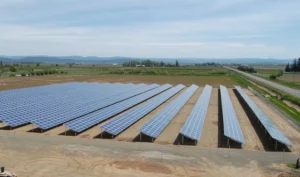Solar Farms: everything you need to know
Solar farms, large-scale photovoltaic installations, are becoming increasingly popular as a source of clean, renewable energy. These plants harness solar energy to generate electricity, helping to reduce carbon emissions and combat climate change. In this article, we will explore the benefits of solar farms, installation and maintenance costs, and estimated returns and profits.

Benefits
Solar farms offer many advantages, including the use of non-productive land and low operating costs. They can be built on unused land such as closed landfills, polluted sites, or marginal agricultural land. The costs of installing a solar farm vary depending on the size of the plant, the technology used, and its geographic location. On average, these costs range between $0.89 and $1 per watt. For example, a 1 MW solar farm will cost between $890,000 and $1 million.
Installation and maintenance costs
The maintenance costs of a solar farm depend on its size, the technology used, and its geographic location. In general, maintenance costs are a small part of the total cost of the installation per year. Maintenance includes cleaning and weed removal as well as general maintenance of the area.
Here is an overview of estimated costs:
- Maintenance cost: Maintenance of a solar farm includes cleaning the solar panels to ensure efficiency, preventing plant growth over the panels, and general maintenance of the area. Maintenance costs depend on the size of the facility and its complexity. In general, the maintenance costs of a solar farm are estimated to be between 1 percent and 2 percent of the total plant cost per year.
- Solar panel cleaning: Solar panel cleaning can be done manually or using automated systems. Cleaning costs clearly depend on the size of the system and its accessibility. On average, solar panel cleaning costs are estimated between $0.01 and $0.05 per watt.
- General Maintenance: General maintenance of a solar farm includes checking electrical cables, inspecting inverters, and maintaining solar panel support structures. General maintenance costs depend on the size of the system, the type of supports (fixed or tracking), and its complexity. On average, general maintenance costs are estimated between $0.01 and $0.03 per watt.
- Insurance: Installations require insurance to protect the investment from damage caused by events such as fire, storms, hail, or vandalism. Insurance costs depend on the size of the plant and its geographical location. On average, insurance costs are estimated between $0.01 and $0.02 per watt.
- Replacement of components: Over the lifetime of a solar farm, some components, such as inverters or electrical cables, may need to be replaced. Replacement costs depend on the size of the system and its complexity. On average, component replacement costs are roughly estimated to be between $0.01 and $0.02 per watt.
In general, the maintenance costs of a solar farm are a small percentage of the total cost of the system and can be amortized by the economic benefits of solar energy production. In addition, the maintenance costs of solar farms are generally lower than those of residential or commercial solar systems because of their scale and greater efficiency in operation and maintenance.
Performance of solar farms
Despite high initial costs, solar farms can generate a significant return on investment. For example, a 1 MW farm can generate an annual return of about $40,000 by selling energy. The payback time of the investment depends on initial costs, energy prices and government incentive policies. Several factors must also be considered, including its size, geographic location, orientation of solar panels, and weather conditions. Here are the key points:
- Size: Solar farms can vary greatly in size, with some covering only a few acres and others spanning square miles. In general, a larger solar farm will have a greater capacity for power generation.
- Type of panels: there are different types of solar panels, and their efficiency varies, albeit slightly. From monocrystalline to polycrystalline through double-sided, we have different efficiencies.
- Geographic location: The location of a solar farm is critical to its performance. Areas with high solar irradiance, such as desert regions, are ideal for installing solar farms. For example, the Sol del Desierto Solar Plant in Chile has a generating capacity of 230 MW and produces 714 GWh per year.
- Orientation of solar panels: The orientation of solar panels can affect the overall performance of a solar farm. In general, solar panels are installed facing the equator so as to maximize sunlight absorption during peak hours.
- Climatic conditions: Weather conditions, temperature, and the presence of clouds or fog, can affect the performance of a solar farm. However, even in diffuse light conditions, solar panels can still produce energy, albeit at a lower rate.
- Maintenance: Proper maintenance of solar panels and energy conversion systems is essential to ensure optimal performance of a solar farm over the years.
In general, a well-designed solar farm located in an area with a high rate of solar irradiation can produce a significant amount of clean, renewable energy.
Agrivoltaics
Also worth mentioning is a relatively new technique, agrivoltaics, which combines power generation with agriculture. The benefits are enormous, expecially against drought, and it is worth continuing to test this practice under all possible conditions. In case you are interested in building a solar farm, please also inquire about the possibilities of agrivoltaics.
Examples of solar farms
A concrete example of a successful solar farm is the Noor-Ouarzazate complex in Morocco. This 580 MW solar farm is the largest in the world and saves the planet from more than 760,000 tons of carbon emissions. The Kamuthi solar farm in India, with a capacity of 648 MW, is another example of a successful solar farm. Covering an area of 2,500 acres, this solar farm can power more than 150,000 homes.
Solar farms offer numerous advantages as a clean, renewable energy source. Despite high initial costs, the estimated returns and profits can be significant. With successful concrete examples such as the Noor-Ouarzazate complex in Morocco and the Kamuthi solar farm in India, these enterprises are demonstrating their crucial role in the transition to a sustainable energy future.


2 thoughts on “Solar Farms: everything you need to know”